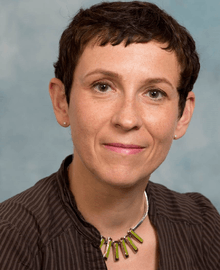Anne Bertolotti
Anne Bertolotti FMedSci is a molecular biologist who is a group leader at the MRC Laboratory of Molecular Biology. She studies the deposition of misfolded proteins in cells, a hallmark of many neurological diseases, and has translated her research by developing new drug candidates that may progress the treatment of age-related degenerative disease.[1]
Anne Bertolotti | |
|---|---|
 | |
| Known for | Studies on neurodegenerative disease |
| Awards | FMedSci, EMBO membership, Hooke Medal, GlaxoSmithKline Award |
| Scientific career | |
| Fields | Biology |
| Institutions | MRC Laboratory of Molecular Biology |
Education and academic career
Bertolotti studied for her PhD with Lazlo Tora and Pierre Chambon at the University of Strasbourg in France.[2] She pursued her post doctoral training with David Ron at the Skirball Institute of Biomolecular Medicine, NYU Medical Center, New York, United States.[2] In 2001, Bertolotti became Associate Professor at Ecole Normale Superieure, Paris. In 2006, she became a group leader at the MRC Laboratory of Molecular Biology.[2]
Professional associations and awards
- In 2004, EMBO Young Investigator Award [3]
- In 2013, Bertolotti was elected to EMBO membership [4]
- In 2014, Bertolotti was awarded the Hooke Medal by the British Society for Cell Biology [2]
- In 2017, Bertolotti was elected Fellow of the Academy of Medical Sciences (FMedSci) [5]
- In 2017, Bertolotti received the GlaxoSmithKline Award from the Biochemical Society [6]
Bertolotti's citation on election as Fellow of the Academy of Medical Sciences (FMedSci) in 2017 reads:
Anne Bertolotti, Programme Leader at the MRC Laboratory of Molecular Biology, is leading research internationally into human neurodegenerative diseases. She has worked on huntingtin aggregation and the assembly of mutant superoxide dismutase (SOD) 1 showing that huntingtin aggregation is context-dependent. She uncovered the mechanisms by which SOD1 mutations generate aggregates and her work on the prion-like properties of assembled SOD1 was pioneering and influenced studies on other protein assemblies. Following on from her discovery of several factors that are part of the cell's response to the perturbation of proteasome degradation, Anne's most recent work has led to the identification of an evolutionarily conserved pathway that controls proteasome homeostasis.
Bertolotti's citation for the GlaxoSmithKline Award from the Biochemical Society in 2017 reads:
Anne has made outstanding contributions to our understanding of the molecular mechanisms underpinning neurodegenerative diseases and has translated her findings towards the therapeutic arena by discovering a new drug candidate (Sephin1) that brings hope for the treatment of age-related diseases. Sephin1 is the first selective inhibitor of a serine-threonine phosphatase. This represents an important discovery because phosphatases were thought to be undruggable. Sephin1 is selective because it targets the regulatory subunit of a phosphatase. There are hundreds of phosphatases that could in principle be inhibited using the same paradigm opening up a broad range of possibilities to safely and selectively manipulate cellular functions, perhaps for therapeutic benefit.
References
- Bertolotti, Anne (Dec 6, 2018). "The split protein phosphatase system". The Biochemical Journal. 475 (23): 3707–3723. doi:10.1042/BCJ20170726. ISSN 1470-8728. PMC 6282683. PMID 30523060.
- "Hooke Medal Winner 2014 – Anne Bertolotti | British Society for Cell Biology". Retrieved 2020-03-07.
- "EMBO report 2004" (PDF).
- User, Super. "EMBO announces new members for 2013". EMBO. Retrieved 2020-03-07.
- "Dr Anne Bertolotti | The Academy of Medical Sciences". acmedsci.ac.uk. Retrieved 2020-03-07.
- Biology, ©2020 MRC Laboratory of Molecular; Avenue, Francis Crick; Campus, Cambridge Biomedical; CB2 0QH, Cambridge; Uk. 01223 267000 (2017-04-11). "Anne Bertolotti receives GlaxoSmithKline Award from the Biochemical Society". MRC Laboratory of Molecular Biology. Retrieved 2020-03-07.
External links
- Anne Bertolotti at the MRC Laboratory of Molecular Biology